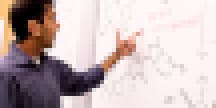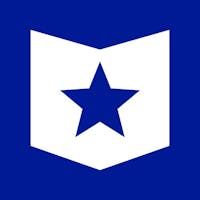YouTube videos for extra credit. Guidebooks to structure group work. A tattoo writing exercise. Vocab riddles. These active learning strategies can work in any course—for any major, in any discipline. A theater professor can be inspired by an organic chemistry professor; an anatomy professor can share a strategy with an economics lecturer; and more. The possibilities are infinite.
Some of the most dynamic thinkers and doers in education today are pioneers in active learning. Their pedagogy promotes the four Cs that the National Education Association (NEA) deems necessary “for success in college, career, and citizenship in the 21st century”: critical thinking, creativity, communication, and collaboration. By swapping a sage on the stage model in favor of a guide on the side approach in the classroom, these professors are helping students engage in their learning journey actively and responsibly—finding aha! moments along the way.
One active learning pioneer, Georgetown University Associate Professor Maria Trujillo, illuminates the underlying philosophy of this approach in the words she shares with students at each semester’s start: “I’m not the expert. I don’t have the answers. But I will coach you. I will mentor you in trying to solve part of this puzzle together. That’s where the future of education is going to be.”
A look inside the classroom and life of Course Hero Master Educator Maria Trujillo of Georgetown University, who helps students explore tech solutions for development challenges in the Global South. Source: Course Hero.
This cross-discipline sharing of ideas is fast becoming accessible to educators everywhere, thanks to emerging technologies and online communities. Professors and other classroom teachers can find a growing library of active learning ideas at Faculty Club, Course Hero’s new channel providing a platform for free electronic collaboration among educators.
JOIN THE CLUB: Educators interested in learning more about Faculty Club opportunities, or being featured in an interview, are invited to reach out to us at educators@coursehero.com.
Common Challenges and Cross-Discipline Innovations
Each article in Faculty Club features an educator who stared down a common classroom challenge, then sought out and applied an innovative approach to active learning. Here, a few recent examples:
Challenge: Encourage competitive students to collaborate
Neil Garg, a professor of organic chemistry at UCLA, knew that students saw his 400-person course as a “weeder class”—an environment that promotes competition. He wanted a way to shake things up and encourage a more collaborative mindset. So he introduced a special extra-credit project, Organic Chemistry Music Videos, in which student groups create video parodies of popular songs—changing all the lyrics to terms and concepts from OChem. The result? Students learn their “electrophilic substitutions,” and wind up as study partners to boot. (They make some pretty entertaining videos, too.)

Challenge: Promote resilience among first-year students
William & Mary theatre professor Laurie Wolf knew that her students would need to be "their biggest selves" in order to be successful on the stage. But she also knew that first-year students often come into class feeling scared, lonely and vulnerable—and reluctant to take risks. Her innovation? A study of Hollywood divas. Using Judy Garland as one example, Wolf demonstrates how these larger-than-life stars faced their own struggles and feelings of impostor syndrome—and developed the resilience to rise above them. By exploring these mechanisms, her students begin to learn how to balance vulnerability and strength.

Challenge: Shake up preconceived notions of culture
Students may think they understand culture, but their understanding is often surface-level, notes John Branch, a professor of business administration at University of Michigan’s Ross School of Business. To help them become more self-aware—and to stoke their curiosity—he introduced a quiz that he knew students could not possibly pass. Questions might include: “In which North African country was the music style rai created?” Or, "Which small Central Asian country recently celebrated the 1,000th anniversary of its national folkloric tale Manas?" Students might know some answers, but they are unlikely to know all of the answers. The exercise sets the stage for deeper learning about culture that is vital to the course’s topic, international marketing.
AN INVITATION: Apply for the Course Hero – Woodrow Wilson Excellence in Education Fellowship. This $20,000–$30,000 grant is available to tenure- and non-tenure-track educators who are interested in active learning and pedagogical innovation in higher ed. Applications are due Friday, November 9, 2018, at 5 p.m. EST.
Challenge: Shift students’ focus from grades to deep learning
Shanina Sanders Johnson, an organic chemistry professor at Spelman College, and Cari Gillen-O'Neel, a psychology professor at Macalester College, each noticed that their students were stressed—almost to the point of distraction—by their grades. Johnson, who wanted to help students course-correct before midterms, developed an innovative combination of high-stakes and low-stakes assignments and assessments that provide ongoing feedback. For her part, Gillen-O'Neel has implemented what she calls a “Contract for B,” in which students promise to take risks in pursuit of learning—knowing that if they make an honest effort, their GPA will not suffer. Both women found that the strategies help students produce their best work.
The Impact in the Classroom: Aha! Moments
Regardless of where we sit in the classroom, it is not always easy to push boundaries and challenge the status quo, says Marcus Collins, another Faculty Club educator from the University of Michigan. “Our brains don’t like us to be in an uncomfortable place,” he explains. “We direct our cognitive energy to a place of what’s called cognitive equilibrium.” But Collins and these other active learning educators are finding that by putting themselves and their students into disequilibrium, the aha! moment they seek is almost inevitable.

As more and more educators continue to challenge their perceptions of what it means to teach in the 21st-century classroom, this type of open mindedness—and innovation—just may become the new status quo.



